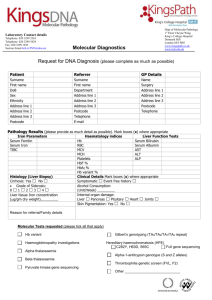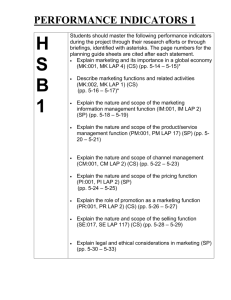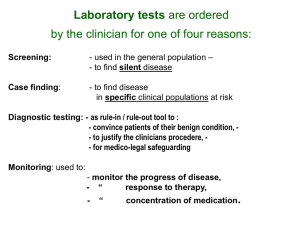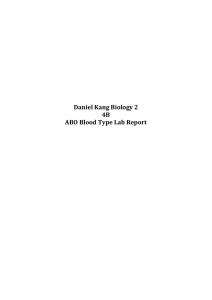Serum Enzymes in Hepatobiliary carcinoma
advertisement
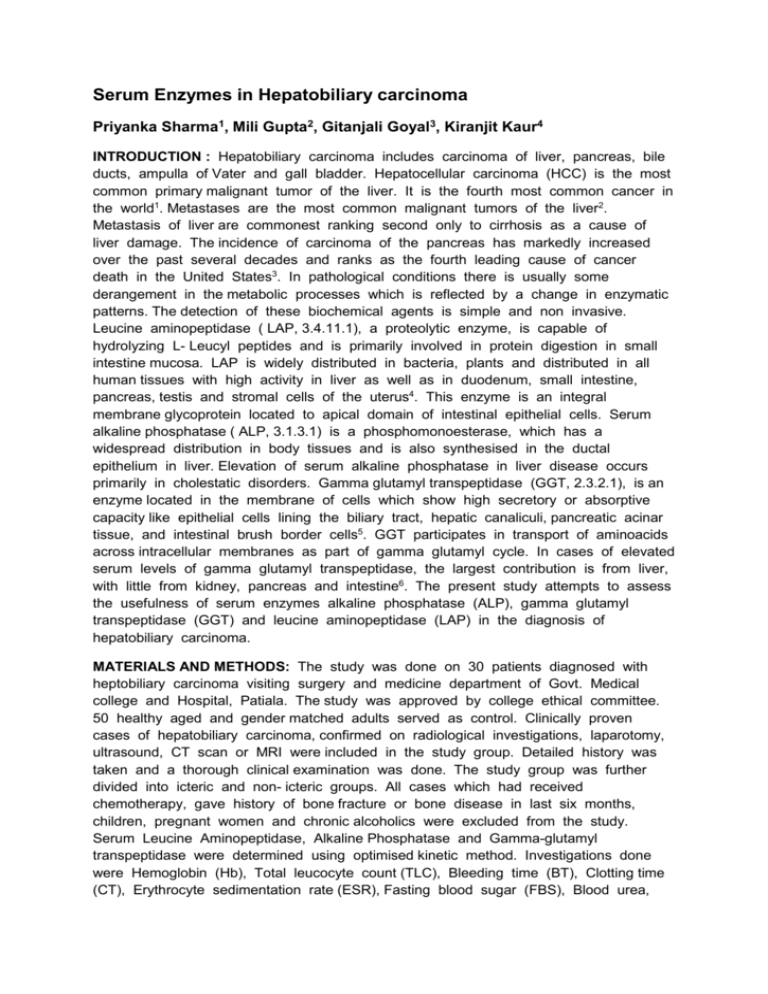
Serum Enzymes in Hepatobiliary carcinoma Priyanka Sharma1, Mili Gupta2, Gitanjali Goyal3, Kiranjit Kaur4 INTRODUCTION : Hepatobiliary carcinoma includes carcinoma of liver, pancreas, bile ducts, ampulla of Vater and gall bladder. Hepatocellular carcinoma (HCC) is the most common primary malignant tumor of the liver. It is the fourth most common cancer in the world1. Metastases are the most common malignant tumors of the liver2. Metastasis of liver are commonest ranking second only to cirrhosis as a cause of liver damage. The incidence of carcinoma of the pancreas has markedly increased over the past several decades and ranks as the fourth leading cause of cancer death in the United States3. In pathological conditions there is usually some derangement in the metabolic processes which is reflected by a change in enzymatic patterns. The detection of these biochemical agents is simple and non invasive. Leucine aminopeptidase ( LAP, 3.4.11.1), a proteolytic enzyme, is capable of hydrolyzing L- Leucyl peptides and is primarily involved in protein digestion in small intestine mucosa. LAP is widely distributed in bacteria, plants and distributed in all human tissues with high activity in liver as well as in duodenum, small intestine, pancreas, testis and stromal cells of the uterus4. This enzyme is an integral membrane glycoprotein located to apical domain of intestinal epithelial cells. Serum alkaline phosphatase ( ALP, 3.1.3.1) is a phosphomonoesterase, which has a widespread distribution in body tissues and is also synthesised in the ductal epithelium in liver. Elevation of serum alkaline phosphatase in liver disease occurs primarily in cholestatic disorders. Gamma glutamyl transpeptidase (GGT, 2.3.2.1), is an enzyme located in the membrane of cells which show high secretory or absorptive capacity like epithelial cells lining the biliary tract, hepatic canaliculi, pancreatic acinar tissue, and intestinal brush border cells5. GGT participates in transport of aminoacids across intracellular membranes as part of gamma glutamyl cycle. In cases of elevated serum levels of gamma glutamyl transpeptidase, the largest contribution is from liver, with little from kidney, pancreas and intestine6. The present study attempts to assess the usefulness of serum enzymes alkaline phosphatase (ALP), gamma glutamyl transpeptidase (GGT) and leucine aminopeptidase (LAP) in the diagnosis of hepatobiliary carcinoma. MATERIALS AND METHODS: The study was done on 30 patients diagnosed with heptobiliary carcinoma visiting surgery and medicine department of Govt. Medical college and Hospital, Patiala. The study was approved by college ethical committee. 50 healthy aged and gender matched adults served as control. Clinically proven cases of hepatobiliary carcinoma, confirmed on radiological investigations, laparotomy, ultrasound, CT scan or MRI were included in the study group. Detailed history was taken and a thorough clinical examination was done. The study group was further divided into icteric and non- icteric groups. All cases which had received chemotherapy, gave history of bone fracture or bone disease in last six months, children, pregnant women and chronic alcoholics were excluded from the study. Serum Leucine Aminopeptidase, Alkaline Phosphatase and Gamma-glutamyl transpeptidase were determined using optimised kinetic method. Investigations done were Hemoglobin (Hb), Total leucocyte count (TLC), Bleeding time (BT), Clotting time (CT), Erythrocyte sedimentation rate (ESR), Fasting blood sugar (FBS), Blood urea, Serum creatinine, TSP, DSP (serum albumin and glopulin), serum amylase, serum bilirubin, Aspartate Transaminase (AST) and Alanine Transaminase (ALT). Serum leucine aminopeptidase (LAP) was determined by optimised kinetic method according to the recommendations of the German society of Clinical Chemistry7. When L-leucylp-nitroanilide is acted upon by the enzyme leucine aminipeptidase, p-nitroaniline is liberated. The absorption of p-nitroaniline is very high at 405 nm, whereas the substrate hardly absorbs at all at this wavelength. The absorbance is read at 405 nm and is directly proportional to the enzyme activity. Reagents : Buffered substrate solution (1,6 mM in 0.05M tris Buffer, pH - 7.2): 40.2 mg of L-leucyl-p-nitroanilide was dissolved in 2 ml of 96% ethanol and made upto 100 ml with tris buffer. The freshly prepared solution had an absorbance between 0.090 and 0.095 against distilled water at 405 nm. Reagent was freshly prepared each time and was stored in dark coloured bottle. Serum ALP was measured by kinetic method and the kit was supplied by Accurex Biomedical Pvt. Ltd., Mumbai. For GGT, the methodology used was of Ssaz8, using single reagent chemistry by kinetic (IFCC) method and the kit used was supplied by Erba/ transasia Biomedical Pvt. Ltd., Mumbai. Serum levels were again estimated and compared after one month of treatment in the form of surgery, radiotherapy or chemotherapy. RESULTS: There was no statistical significant difference in the mean age and sex distribution of study and control groups. Loss of appetite and weight were the main presenting symptoms. (Figure I). Distribution of patients according to diagnosis is depicted in Figure 2. The study group was further divided into icteric and non-icteric groups depending upon the presence or absence of icterus (Figure 3). Serum bilirubin, AST and ALT were found to be significantly higher in study group as compared to control group (Table 1). The mean levels of serum ALP, GGT and LAP in the study group before initiation of treatment were 786.3±465.05 IU/L, 193.3±116.73 IU/L and 96.86±34.74 IU/L respectively. These values were significantly higher than in the control group (Table 2). Out of 30 patients of hepatobiliary carcinoma, serum LAP showed abnormal levels in maximum number of cases (93.3%) followed by serum GGT in 83.3% and serum ALP in 76.6% cases (Table 3). Thus, it is observed that out of the three enzymes, serum LAP is the most sensitive index of hepatobiliary carcinoma. Levels of all the three enzymes ie., ALP, GGT and LAP were significantly higher in icteric and non-icteric groups as compared to control group. Also, icteric group showed higher values than the non-icteric group, the difference being highly statistically significant (tables 4 and 5). LAP was significantly raised (p<0.001) in the icteric as compared to the non-icteric group. 15 out of 16 ( 93.75%) nonicteric cases had elevated LAP. This was followed by GGT, raised in 12/16 (75%) nonicteric cases and ALP raised in just 9/16 (56.25%) nonicteric cases.(Tables 6). Therefore, it is observed that LAP is the most frequently elevated enzyme in non-icteric patients. The serum levels of ALP, GGT and LAP before and after treatment are compared in table 7. Out of 30 patients in the study group, only 26 could be followed up because three patients had expired and one refused to follow-up. Though the mean levels of all three enzymes decreased on the follow-up, the difference was not significant statistically. 30 27 26 23 25 20 17 14 15 10 10 5 0 Loss of Appetite Loss of weight Pain abdomen Fever Icterus Mass abdomen Fig.1 : showing distribution of patients according to general presenting symptoms 14 14 12 10 8 6 6 6 4 2 2 2 0 Liver metastasis Carcinoma Gallbladder Carcinoma Pancreas Periampullary Carcinoma Fig.2: showing distribution of patients according to diagnosis Carcinoma bileduct Icteric 47.67% Non-icteric 53.33% Fig.3: showing icteric and nonicteric cases of study group Parameter Group Bilirubin (mg%) AST (IU/L) ALT (IU/L) Range Mean±SD Study 0.4-14.2 3.15±3.65 Control 0.1-0.9 0.48±0.19 Study 30-220 107.3±70.14 Control 10-35 21.26±7.4 Study 18-160 67.83±49.60 Control 12-32 23.18±6.32 Table 1: showing serum Bilirubin, AST and ALT groups Enzyme Group t p Significance 5.16 <0.001 HS 8.63 <0.001 HS 6.30 <0.001 HS levels in study and control No. of Range Mean±SD t Patients (IU/L) (IU/L) ALP Study 30 220-1650 786.3±465.05 9.51 Control 50 112-240 159.48±38.05 GGT Study 30 30-410 193.3±116.73 10.74 Control 50 8-42 16.02±7.55 LAP Study 30 36-176 96.86±34.74 12.87 Control 50 27-40 33.02±4.41 Table 2: Comparison of serum ALP, GGT and LAP levels in study p Significance <0.001 HS <0.001 HS <0.001 HS and control groups. Level of ALP Enzyme No. Normal 7 Above 23 normal Total 30 Table 3: showing frequency of Enzyme GGT %age 23.33 76.67 No. 5 25 LAP %age 16.67 83.33 No. 2 28 %age 6.67 93.33 100 30 100 30 100 elevation of serum ALP, GGT and LAP in study group Values (IU/L) Control (C) Icteric (I) Non-icteric (NI) (n=50) (n=14) (n=16) ALP Range 112-240 880-1650 220-860 Mean±SD 159.48±38.05 1215.42±258.83 410.81±194.45 GGT Range 8-42 42-410 30-340 Mean±SD 16.02±7.55 271.78±100.78 124.62±82.23 LAP Range 27-40 38-176 36-150 Mean±SD 33.02±4.41 116.71±31.64 79.5±27.87 Table 4: Comparision of serum ALP, GGT and LAP levels of control group Vs icteric and non-icteric patients of study group. Enzyme ALP Comparison t P Significance C vs I 28.33 <0.001 HS C vs NI 8.76 <0.001 HS I vs NI 9.7 <0.001 HS GGT C vs I 18.13 <0.001 HS C vs NI 9.36 <0.001 HS I vs NI 4.40 <0.01 HS LAP C vs I 18.43 <0.001 HS C vs NI 11.52 <0.001 HS I vs NI 3.42 <0.01 HS Table 5 : Statistical analysis of comparision of serum ALP, GGT and LAP levels of control group (C) Vs icteric (I) and non-icteric (NI) patients of study group. Enzyme Icteric (n=14) Normal Above Normal No. %age No. %age ALP 14 100 GGT 1 7.14 13 92.86 LAP 1 7.14 13 92.86 Table 6: showing frequency of elevation of in icteric and non-icteric groups. Non-Icteric (n=16) Normal Above Normal No. %age No. %age 7 43.75 9 56.25 4 25.0 12 75.0 1 6.25 15 93.75 serum ALP, GGT and LAP Enzyme Time Mean±SD Mean t p Significance change±SD ALP Before 738.03±439.38 177.73±217.91 1.62 >0.05 NS After 560.3±346.4 GGT Before 184.76±118.55 50.42±45.15 1.74 >0.05 NS After 134.36±87.26 LAP Before 93.5±33.4 16.96±17.01 1.94 >0.05 NS After 76.53±29.51 Table 7: Statistical analysis of enzyme levels of study group before and after the treatment (n=26) DISCUSSION : The present study was intended to compare the levels of serum enzymes – ALP, GGT and LAP in patients suffering from hepatobiloary carcinoma with the age and gender matched controls, and to note any difference of these enzymes a month after initiation of treatment. Serum ALP levels were found to be a reliable index of metastatic liver disease 9,10,11. Monitoring the elevation of ALP levels in patients of colorectal carcinoma may be used as an indicator of subsequent liver metastases12. On the contrary, another finding showed that serum ALP doesnot increase significantly in cases of liver metastasis13. Increase in ALP activity also occurs in bone diseases due to increased activity of osteoblasts14,15. It has been suggested that in the hepatobiliary diseases, there is increased synthesis of ALP by the hepatocytes which results in increased enzyme levels in circulation14. Hepatic ALP is normally present on the apical domain (ie, canalicular) of the hepatocyte plasma membrane and in the luminal domain of bile duct epithelium. In cholestasis, retained bile acids solubilise the hepatocyte plasma membrane and facilitate release of ALP 16,17,18 . The increase levels of serum GGT result from cholestasis in which the bile acids solubilise the hepatic membrane bound enzyme 19,20. It is also suggested that the tumor itself may contribute to raised GGT levels because of the pronounced GGT activity of malignant liver cells 21,22. Studies from several authors have shown raised levels of serum GGT in liver metastasis 10,11. GGT was increased in most of the patients (70%) of liver metastases 23. Serum GGT is an important marker for Hepatitis B virus-related combined hepatocellular-cholangiocarcinoma24. It is shown that serum GGT is not elevated in bone disorders 25,26. Thus measurement of serum GGT helps us to distinguish whether bone or liver is the source of increased levels of serum ALP. Elevation of serum GGT levels is an indicator of aggressive tumor behaviors and a predictor of poor clinical outcomes. It may prove to be a useful biomarker for identifying intrahepatic cholangiocarcinoma (ICC) patients at high risk of early recurrence and unfavorable prognosis 27. Out of the three enzymes, serum LAP was found to be raised in maximum number of cases (93.3%) followed by GGT and ALP in 83.3% and 73.3% cases respectively. LAP is found to be the most sensitive enzyme in hepatobiliary carcinoma 28. Abnormal levels of serum LAP were reported in 100% of cases of carcinoma pancreas and 93% cases of liver metastasis 29. LAP is raised in diseases of liver and hepatobiliary duct system and the diseases not involving liver and bileduct system are seldom associated with increased LAP 30. Increased LAP was due to obstruction of common bile duct by the tumour or liver metastasis or both. Significantly elevated LAP levels were observed in liver metastasis 31,32. A rise in serum LAP is detected in patients of hepatobiliary pancreatic carcinoma 28. LAP was found to be elevated in papillary adenocarcinoma of bile duct 33, and in cholestatic liver disease 34. Non-significant elevations of LAP were observed in cases of carcinoma gallbladder without liver metastasis 35. Serum LAP is not significantly elevated in malignant liver disease as compared to benign liver disease 36. Patients with liver metastasis of non-pancreatic origin and without jaundice had increased LAP levels suggesting that hepatic infilteration is the cause of rise in liver metastasis 29. Cholestatic liver diseases are characterized by impaired hepatocellular secretion of bile, resulting in intracellular accumulation of bile acids which result in a shift in the oxidant/prooxidant balance in favor of increased free radical activity and injury of different tissues 37. It is concluded that rise in LAP seen in both icteric and non-icteric groups was due to hepatocellular dysfunction. Whereas ALP and GGT showed greater rise in icteric group as compared to non-icteric group indicating that hepatic dysfunction with jaundice was the cause of elevated levels, LAP rises with hepatic dysfunction irrespective of jaundice, it is a better indicator of hepatobiliary malignancy 28. Lowering of LAP levels was either due to removal of primary tumour or suppression of primary tumour with subsequent decrease in size of secondaries by various modes of treatment (surgery, radiotherapy or chemotherapy). Fall in levels were not statistically significant because the residual tumour still remained in the body. Moreover these estimations were done when patients were still taking the treatment in the form of radiotherapy or chemotherapy and high levels may have not disappeared from the circulation. These patients may have shown fall in the levels after completion of treatment. CONCLUSIONS : All the three enzymes i.e. ALP, GGT and LAP are significantly elevated in the patients with hepatobiliary carcinoma and the elevations are significantly higher in icteric patients as compared to nonicteric patients. Out of these enzymes, LAP is the most sensitive in diagnosis of hepatobiliary carcinoma. It is more useful in the screening of non-icteric cases of hepatobiliary carcinoma as it rises more frequently in non-icteric cases. Thus serum LAP is a better indicator of hepatobiliary carcinoma. Monitoring LAP is a simple, low cost, and relatively sensitive screening tool for detecting hepatobiliary carcinoma. REFERENCES : 1. Parkin DM, Whelan SL, Ferlay J, et al., eds.: Cancer Incidence in Five Continents. Volume VII. Lyon, France: International Agency for Research on Cancer, 1997. 2. Kasper HU, Drebber U, Dries V, Dienes HP; liver metastasis : incidence and histogenesis. Z Gastroenterol. 2005 Oct; 43 (10): 1149-57. 3. Silverman DT, Schiffman M, Everhart J, et al.: Diabetes mellitus, other medical conditions and familial history of cancer as risk factors for pancreatic cancer. Br J Cancer 80 (11): 1830-7, 1999. [PUBMED Abstract] Int J Urol. 2007 Apr; 14 (4): 289-93. 4. Smith EL and Hill RL: Leucine Aminopeptidase. In : The Enzymes Eds. P.D.Boyer, H. Lardy, and K.Myrbak. Acedmic Press, New York and London Inc. 1960; Vol 4: 37-62 5. Meister A and Anderson ME : Glutathione .Ann Rev Biochem 1983 ; 52 :744-760 6. Husby NE : Separation and character of human GGT. Adv Biochem Pharmacol 1982 ; 3 : 47-54 7. Ssaz G : A kinetic photometric method for serum leucine aminopeptidase. Amer J Clin Patho 1967; 24 : 607-613. 8. Ssaz G : A kinetic photometric method for serum GGT. Clin Chem 1969 ; 15 : 124-126. 9. Huguier M and Lacaine F : Hepatic metastasis in Gastrointestinal cancer. Arch surg 1981; 116 : 399-401 10. Rusia U, Dewan A, Raj GA et al : Enzyme profile in metastatic liver disease. Indian J Med Res 1984 ; 80 : 321-326 11. Yeshowardhan, Singh VS, Pratap VK et al : Serum enzymes in carcinoma gastrointestinal tract. Ind J Cancer 1984 ; 21 : 146-156. 12. M. Wasif Saif, Dominik Alexander, and Charles M. Wicox : Serum Alkaline Phosphatase Level as a Prognostic Tool in Colorectal Cancer: A Study of 105 patients. J Appl Res. 2005; 5 (1): 88–95 13. Pande GK, Sarin R and Kapur BML : Reliability of serum 5’- nucleotidase, alkaline phosphatase and liver scan in hepatic metastasis. Indian J of Surg 1992 ; 54 (5) : 185-188 14. Moss DW : Diagnostic aspects of alkaline phosphatase and its isoenzymes. Clin Biochem 1987 Aug ; 20 (4) : 225-230. 15. Ferraz-de-Souza B, Correa PH : Diagnosis and treatment of Paget's disease of bone : a mini-review ; Arq Bras Endocrinol Metabol. 2013 Nov ; 57 (8) : 577-82. 16. Seetharam S, Sussman N L, Kimoda T et al : The mechanism of elevated alkaline phosphatase activity after bile duct ligation in the rat. Hepatology 1986 ; 6 : 374-380. 17. Hatoff ED and hardison WGM : Bile acids modify alkaline phosphatase induction and bile secretion pressure after bile duct obstruction in the rat during cholestasis, Gastroenterology 1981 ; 80 : 668-672. 18. Schlaeger R, Haux P and Kattermann R : Studies on the mechanism of the increase in serum alkaline phosphatase activity in cholestasis : significance of the hepatic bile acid concentration for the leakage of alkaline phosphatase from the rat liver. Enzyme 1982 ; 28 : 3-13 19. Husby NE and Torstein V : The activity of gamma glutamyl-transferase after bile duct ligation in guinea pig. Clin Chem Acta 1978 ; 88 : 385-392 20. Hirata E, Inoue M and Morino Y : Mechanism of biliary secretion of membranous enzymes : Bile acids are important factors for biliary occurrence of gamma glutamyl-transferase and other hydrolases. J Biochem 1984 ; 96 : 289297. 21. Kokot F, Kuska J, Grzybex H et al : Gamma glutamyl- transpeptidase in tumour diseases. Arch Immunol. Ther Exptl 1965 ; 13 : 586-592 22. Aronsen KE, Hagerstrand I, Norden JG et al : On the causes of the increased activity of alkaline phosphatase and gamma glutamyl-transferase in serum of patients with liver metastasis. Acta Chir Scand 1969 ; 135 : 619-624 23. Simic T, Dragicevic D, Savic-Radojevic A et al : Serum gamma glutamyltransferase is a sensitive but unspecific marker of metastatic renal cell carcinoma. J Appl Res. 2005 ; 5 (1) : 88–95. 24. Chu KJ, Lu CD, Dong H et al : Hepatitis B virus - related combined hepatocellular-cholangiocarcinoma : clinicopathological and prognostic analysis of 390 cases. Eur J Gastroenterol Hepatol. 2014 Feb ; 26 (2) : 192-9. 25. Betro MG, Oon RCS and Edwards JB : Gamma glutamyl-transferase in diseases of the liver and bone. Am J Clin Pathol 1973 ; 60 : 672-678 26. Lum G and Gambino SR : Serum gamma glutamyl- transpeptidase activity as an indicator of disease of the liver, pancreas and bone. Clinical Chemistry 1972 ; 18 (4) : 358-362. 27. Yin X, Zheng SS, Zhang BH et al : Elevation of serum γ-glutamyltransferase as a predictor of aggressive tumor behaviors and unfavorable prognosis in patients with intrahepatic cholangiocarcinoma : analysis of a large monocenter study. ; Eur J Gastroenterol Hepatol. 2013 Dec ; 25 (12) : 1408-14. 28. Ghadge MS, Sirsat AV, Bhansali MS et al : Leucine aminopeptidase a better indicator of carcinoma of liver, biliary tract and Pancreas. Indian Journal of Clinical Biochemistry 2001 ; 16 (1) : 60-64 29. Bressler R, Forsyth BR and Klatskin G : Serum leucine aminopeptidase activity in hepatobiliary and pancreatic disease. J Lab Clin Med 1960 ; 56 : 417-30. 30. Batsakis JG, Kremers BJ, Thiessen MM et al : “ Biliary tract Enzymology.” A clinical comparison of serum alkaline phosphatase, leucine aminopeptidase and 5’- nucleotidase. Am J Clin Pathol 1968 ; 50 (4) : 485-490 31. Mehrotra TN, Singh VS, Mittal HS et al : Leucine aminopeptidase in gastrointestinal cancers. J Assoc Physicians India 1984 ; 32 : 583-584 32. Aziz M, Gupta SK and Khan AA : Serum leucine aminopeptidase profile in cancers of gastrointestinal tract with special reference to hepatic metastasis. J Indian Assoc 1990 ; 88 (6) : 160-163 33. Mori S, Kasahara M : Papillary adenocarcinoma of the subvesical duct ; J Hepatobiliary Pancreat Surg. 2001 ; 8 (5) : 494-8. 34. Bianda T, Bannwart F, Inderbitzi R, Caduff B : [Chronic cholestatic liver disease and grand mal seizures : Dtsch Med Wochenschr. 1996 Aug 16 ; 121 (33) : 1009-14. 35. Sathe SB and Taskar SP : Leucine aminopeptidase levels in hepatic and certain gastrointestinal tract cancers. J Assoc Physicians India 1982 Feb ; 30 (2) : 83. 36. Pasanen P, Pikkarainen P, Alhava E et al : Value of serum alkaline phosphatase, aminotransferase, gamma glutamyl- transferase, leucine aminopeptidase and bilirubin in the distinction between benign and malignant disease causing jaundice and cholestasis : results from a prospective study. Scand J Clin lab Invest 1993 ; 53 : 35-39. 37. Somi MH, Kalageychi H, Hajipour B et al : Lipoic acid prevents hepatic and intestinal damage induced by obstruction of the common bile duct in rats .; Eur Rev Med Pharmacol Sci. 2013 May ; 17 (10) : 1305-10. REFERENCES : 1. Parkin DM, Whelan SL, Ferlay J, et al., eds.: Cancer Incidence in Five Continents. Volume VII. Lyon, France: International Agency for Research on Cancer, 1997. 2. Kasper HU, Drebber U, Dries V, Dienes HP; liver metastasis : incidence and histogenesis. Z Gastroenterol. 2005 Oct;43(10):1149-57. 3. Silverman DT, Schiffman M, Everhart J, et al.: Diabetes mellitus, other medical conditions and familial history of cancer as risk factors for pancreatic cancer. Br J Cancer 80 (11): 1830-7, 1999. [PUBMED Abstract] Int J Urol. 2007 Apr;14(4):28993. 4. Smith EL and Hill RL: Leucine Aminopeptidase.In :The Enzymes Eds.P.D.Boyer, H. Lardy, and K.Myrbak. Acedmic Press, New York and London Inc. 1960; Vol 4: 37-62 5. Meister A and Anderson ME : Glutathione .Ann Rev Biochem 1983 ; 52 :744-760 6. Husby NE : Separation and character of human GGT. Adv Biochem Pharmacol 1982 ;3 : 47-54 7. Ssaz G : A kinetic photometric method for serum leucine aminopeptidase. Amer J Clin Patho 1967; 24 : 607-613. 8. Ssaz G : A kinetic photometric method for serum GGT. Clin Chem 1969 ;15 : 124126. 9. Huguier M and Lacaine F : Hepatic metastasis in Gastrointestinal cancer. Arch surg 1981; 116 : 399-401 10. Rusia U, Dewan A, Raj GA et al :Enzyme profile in metastatic liver disease.Indian J Med Res 1984 ; 80 : 321-326 11. Yeshowardhan,Singh VS, Pratap VK et al : Serum enzymes in carcinoma gastrointestinal tract. Ind J Cancer 1984 ; 21 : 146-156. 12. M. Wasif Saif, Dominik Alexander, and Charles M. Wicox, Serum Alkaline Phosphatase Level as a Prognostic Tool in Colorectal Cancer: A Study of 105 patients J Appl Res. 2005; 5(1): 88–95 13. Pande GK, Sarin R and Kapur BML : Reliability of serum 5’- nucleotidase,alkaline phosphatase and liver scan in hepatic metastasis. Indian J of Surg 1992 ; 54 (5) :185-188 14. Moss DW : Diagnostic aspects of alkaline phosphatase and its isoenzymes. Clin Biochem 1987 Aug ; 20 (4) :225-230. 15. Ferraz-de-Souza B, Correa PH : Diagnosis and treatment of Paget's disease of bone: a mini-review ; Arq Bras Endocrinol Metabol. 2013 Nov;57(8):577-82. 16. Seetharam S, Sussman NL, Kimoda T et al : The mechanism of elevated alkaline phosphatase activity after bile duct ligation in the rat. Hepatology 1986 ; 6 : 374380. 17. Hatoff ED and hardison WGM: Bile acids modify alkaline phosphatase induction and bile secretion pressure after bile duct obstruction in the rat during cholestasis, Gastroenterology 1981 ; 80 : 668-672. 18. Schlaeger R, Haux P and Kattermann R : Studies on the mechanism of the increase in serum alkaline phosphatase activity in cholestasis : significance of the hepatic bile acid concentration for the leakage of alkaline phosphatase from the rat liver. Enzyme 1982 ;28 : 3-13 19. Husby NE and Torstein V : The activity of gamma glutamyl-transferase after bile duct ligation in guinea pig. Clin Chem Acta1978 ; 88 : 385-392

